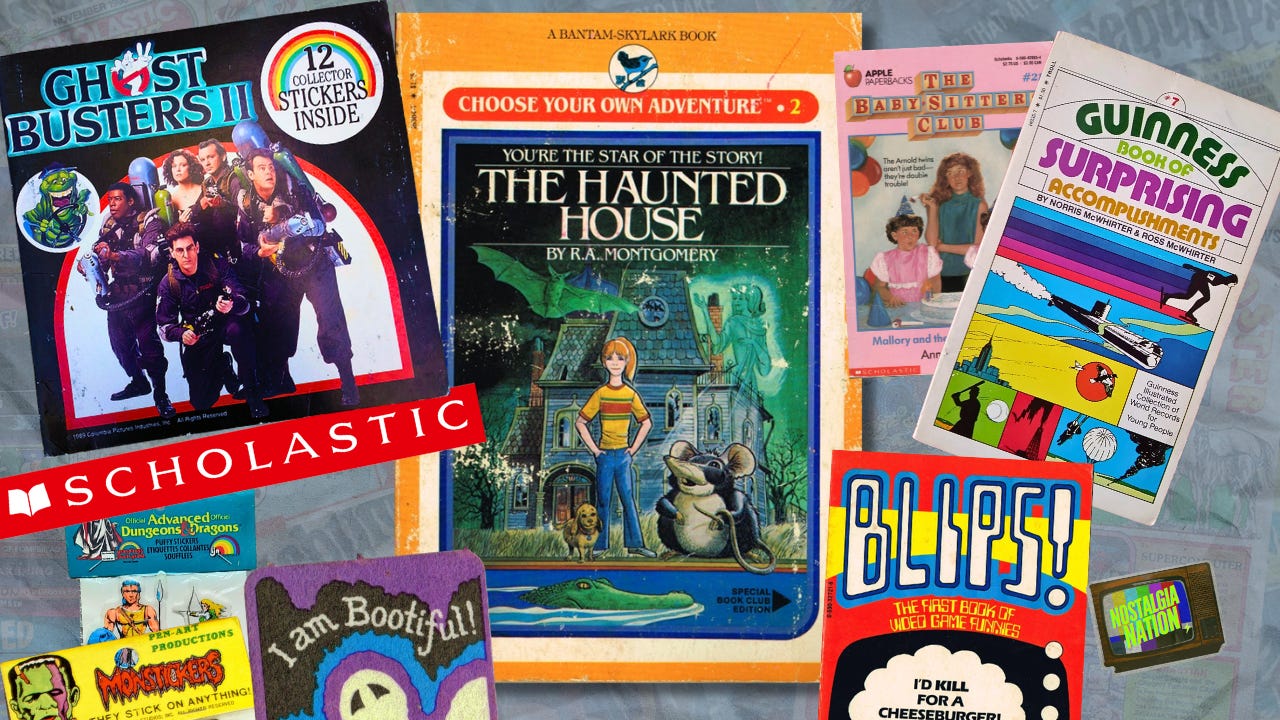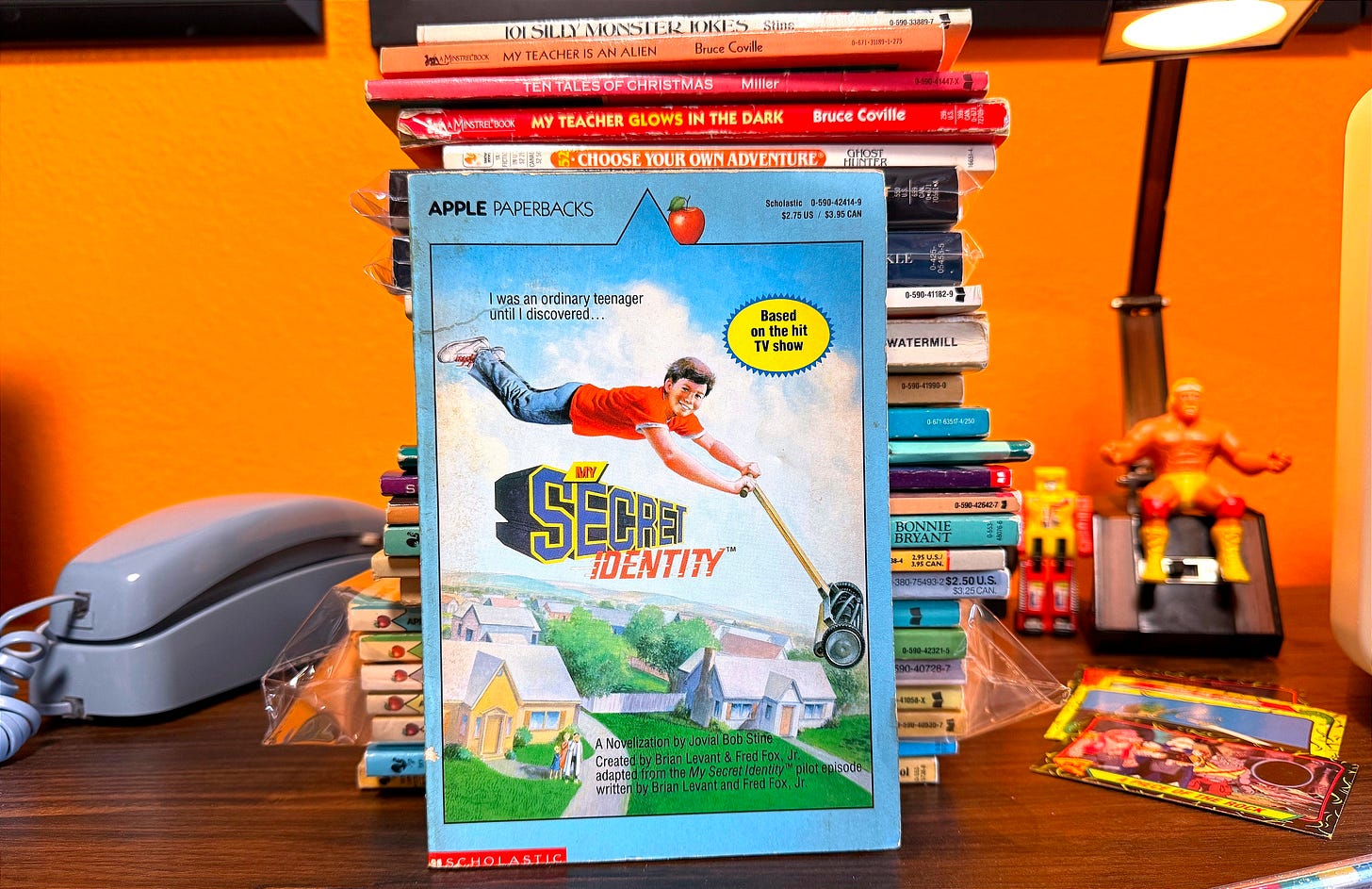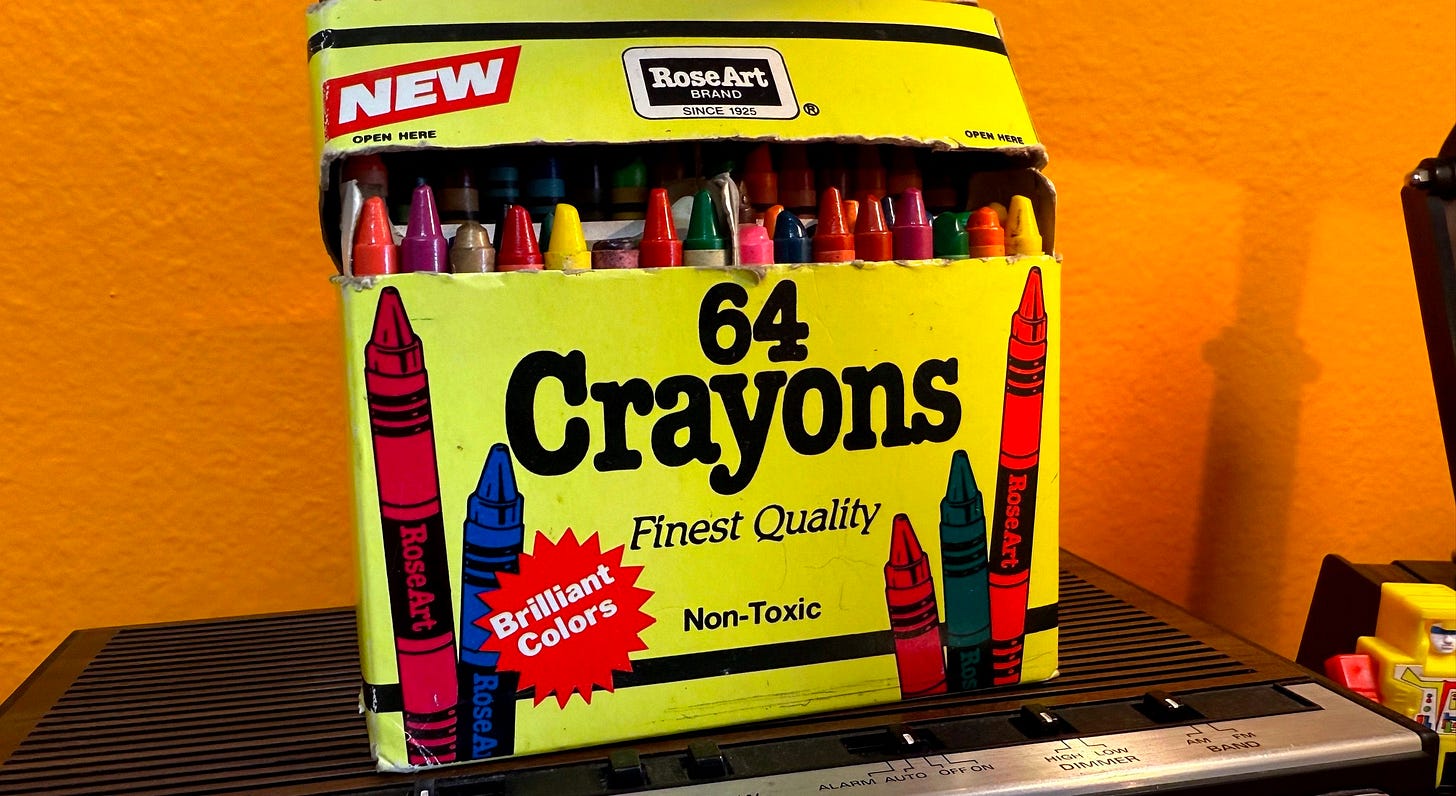Once Upon a Scholastic Book Fair
A Gen X ode to Scholastic book fairs & my guest appearance on 'Two Dollar Late Fee' showing off all my Scholastic books
By the mid-1980s, something magical began popping up in school gyms and libraries across America: a Scholastic Book Fair. The Scholastic Corporation, founded in 1920 as a kids’ magazine publisher, had long run book clubs, but didn’t really get into selling books in schools until 1981, when it bought a California chain of in-school fairs. (Actually, local book-sale events existed decades earlier – there’s a Denver Post photo of an author signing books at a school event in 1952 – but Scholastic’s 1981 buyout supercharged the concept.) In just a few years, Scholastic went from zero to one of the “big three” book-fair companies, and by the 1990s had nearly monopolized elementary school book sales nationwide. Today they mount well over 100,000 fairs a year.
Yet to us, the kids lining up with crumpled orders of $3 bills in hand, Scholastic’s rise to corporate dominance was invisible. All we knew was that, once or twice a year, our drab school cafeteria or library would inexplicably be refitted as a pop-up bookstore full of colorful covers, glittery pens and pencils, and cute classroom tchotchkes, transforming our mundane halls into a treasure trove. For a generation of latchkey kids raised on constant promises of something bigger, the euphoria leading up to book-fair week was palpable – like the anticipation before a big holiday. Teachers would hand out order forms a week in advance, and our only homework was obsessively circling fantasy novels and puffy stickers with fluorescent markers.
Pop-Up Magic: Turning the Gym into a Wonderland
I still remember stepping into the makeshift bookstore on a Friday afternoon: wooden tables bowed under stacks of paperbacks, posters tacked on the walls, and the unmistakable smell of new books and possibility in the air. It was as if Waldenbooks or B. Dalton and the K-Mart toy and school supply sections had magically materialized for a week inside our own school, just for us. Even the school librarian got into it – Mrs. Brown traded her cardigan for a sweater with dollar-sign buttons, and the custodian’s floor cleaner was mysteriously disappeared overnight and a table full of bookmarks and yo-yos appeared over night. For once, the rules of the classroom bent for our delight. We could roam free (mostly under supervisor glare), sniffing glossy pages and reading jacket summaries aloud.
That feeling of mild rebellion was intoxicating. A few measly dollars felt like a fortune to 8-year-old us, and the power to spend it on anything (as long as it was less than $4 and not edible) was heady. Selecting a book all by oneself…was thrilling!
We knew it was almost too good to be true, but in those moments we played by a different set of rules. We stayed up late thumbing through the fair catalogue (pre-internet Blue Book of book porn) and doodling orders, most of us knowing it was all for naught. There were a few select kids that ordered early, and it ate me up inside sometimes that I couldn’t just get what I circulated. Magically, even.
At the end of the week, we’d leave with loot bags of gel pens, bookmarks, and candy-free treasure that had our names on them. Remember being smug carrying a half-read novel home on the bus, your new puffy sticker decorating its cover? Ahh, innocence. I later realized Scholastic’s real trick was giving a kid a set of colorful pens and a paperback, and you get a literate supporter for life!
Coast to Coast: One Big Book Party
By the early 90s, Scholastic’s book fairs weren’t just a local quirk. They were a familiar national event. Every year about 120,000 schools in the U.S. held one, in big cities and small towns alike. Scholastic even bragged about shipping fairs to remote locales by bush plane and ferry. In truth, the book fair was a God send in some places that didn’t have a bookstore in walking distance. Think about that!
Regional flavor aside, the fairs were pretty uniform coast-to-coast. If anything, local touches crept in as personal memories rather than official menus. In Boston maybe you got a Red Sox pennant poster, in Texas a rodeo horse print, in California a surfboard sticker book, but the core merch was identical. That 1990s Scholastic catalog of wonders rolled across the country like a traveling circus: books, stickers, posters and plastics in every color of the 90s crayon box. The only noteworthy geographical pattern was that kids everywhere asked mom or dad for $5 and went wild, and somewhere over the horizon trucks were hauling back whatever they couldn’t sell.
Legends and Loot: What We Cared About
Looking back, the “best” parts of the fair were hilariously predictable. When I say “best,” I mean the items we memorized from the previews and begged for in near-scholarly tones. Some were books that turned out to be surprisingly good, others were pure dollar-store kitsch we adored anyway. Here are a few of the most nostalgia-inducing favorites from the 80s to around 2007 (surely you owned at least one of these!):
Choose Your Own Adventure – A top-10 purchase for most kids in the 80s/90s
Goosebumps – R.L. Stine’s horror series was omnipresent. From Night of the Living Dummy to Goosebumps specials, every third book on the shelf was a creepy pulp thriller.
Animorphs – Aliens + animals = every boy in 5th grade’s dream. These glowing-faced covers were science-fiction catnip.
The Magic School Bus – Fun-science adventures that even mom couldn’t veto. (Ms. Frizzle forever!).
The Baby-Sitters Club – Stacks of girl-power novels about gig economy entrepreneurs, poorly illustrated.
The Black Stallion – There wasn’t a single fair that I’d been to all of my years that didn’t have a version of The Black Stallion!
Captain Underpants (late 90s, but still) – Pilkey’s potty-humor books gave us permission to snort and giggle at government-issue stickers.
Diary of a Wimpy Kid – (Late '00s fare, but familiar by Gen X now) Kinney’s comic-diary comedies had us laughing at puberty-by-proxy.
Harry Potter (Sorcerer’s Stone) – Famously, America first saw HP (paperback edition) through Scholastic’s fair circuit.
Ella Enchanted – Levithan’s Cinderella remix that (briefly) sparked a fairy-tale craze.
Encyclopedia Brown – Boy-genius mysteries that parents loved for their puzzling wordplay.
Garfield comic collections – A sure-sell wiener-dog cat poster or tape-dispenser (mostly cat posters) on kitten money.
Superhero/movie tie-ins – Any series riffing on Marvel heroes, Star Wars, Batman or Cinderella retold for kids, because we ate up anything with a licensed character.
Glittery gel pens and pencils – (Ritzy school supplies). Almost every kid left with a fistful of shiny pencils and neon gel pens.
Colorful bookmarks and sticker packs – Usually freebies at checkout, but we treated them like royal spoils of war. I sometimes asked for more than one, what can I say?
Poster books – Full of glossy film stars, Lamborghinis or BMX bike art for our bedroom walls.
Joke books – Tiny thrillers of knock-knock humor that we traded like Pokémon cards.
Puffy vinyl stickers – (Dinosaurs, rainbows, gross slime bubbles) – who didn’t have a skeleton’s face or Lisa Frank deer stuck on a folder?
Temporary tattoos – Disney or Ninja Turtle arm art that still taunts us in yearbook photos.
Scented erasers (animals, fruit) – Novelty mini-erasers shaped like tigers, oranges or cupcakes. (Yes, we smelled them.)
Slap Bracelets – Fat fabric band bracelets that snapped onto our wrists in bright neon sweeps.
Trading cards/games – Early Pokémon cards (late 90s) or NBA cards sold at Scholastic tables.
Craft kits & stationery sets – Friendship bracelet loops, embossing sticker kits or “design your own stationery” packs.
Keychain trinkets and squishy toys – Plastic creatures on chains, squishy stress-balls, foam puppets, and (in 95+) little Beanie Babies that everyone wanted (damn, the 90s were fire too!).
Some items go in and out of fashion, but in the 80s & 90s book fair ecosystem, these were our Holy Grail tchotchkes. The Scholastic catalog carefully filled tables with new hardcover releases (80% were frontlist titles) alongside enough glittery crap to anesthetize any kid’s senses.
The Fairytale Lingers
Now as grown-ups, many of us still pine for those days. The Scholastic Book Fair was the analog-age equivalent of an app we all loaded up with dopamine. We may have got iPads and Amazon Prime Kids now, but nothing digitally replaces the confusion and thrill of holding a real paperback in first grade and knowing you earned it with your allowance. Every time my kid comes home with a catalog, I get a pang of schadenfreude and nostalgia… the ritual of circling favorites, nagging for just $4 more…and me secretly hoping I stocked up enough sticky-back plastic last year.
The legacy of Scholastic fairs is tremendous. Parents and teachers still cheer them on as events that get kids reading – giving schools a bit of fundraising cash and giving kids the autonomy to choose their own adventures. In the age of e-books and digital indoctrination, there’s power in a week of flesh-and-blood browsing. As Scholastic’s own president puts it, the fair helped transition reading “from an obligation to a choice” for many children. And if nothing else, the annual book fair remains a collective time machine. It momentarily turns every school (no matter if it’s Times Square or Nebraska cornfields) into a magic portal full of the same books, toys, and scents that once made Gen X kids feel like the main character of our own story.
Looking back, we realize how delightfully absurd it all was— a traveling bookstore on wheels that treated mint-flavored erasers like gold. But damn if it wasn’t glorious. For a week each year, we traded math class for treasure hunting, and learned (in a very Gen X way) that joy can still be found in the humblest of pleasures: a few dollars, a shiny pen, and a pile of untold stories waiting to be opened.
If you enjoyed this and want to watch or listen to my guest appearance on the hugely popular podcast “Two Dollar Late Fee,” please select one of the options below. I show off some of my favorite books/items from the Scholastic Book Fair from over the years:
You can also watch the Video version of the podcast here:








